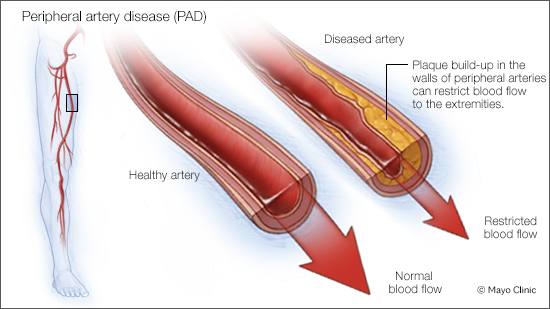-
Cardiovascular
Mayo Clinic Q&A podcast: Early diagnosis of peripheral artery disease reduces risk of amputation, heart attack and stroke

Peripheral artery disease, or PAD, affects almost 10 million people in the U.S. Approximately one-third of patients will die within five years of a peripheral artery disease diagnosis, and 20% will experience a heart attack or stroke.
What is it?
Peripheral artery disease usually involves pain in the lower limbs caused by reduced blood flow due to narrowing of the arteries. Its symptoms, like reduced ability to walk due to leg pain, often are brushed off as signs of aging. While age is a factor, younger people with diabetes or who smoke also should be checked for the disease.
"If you have risk factors for lower-extremity PAD — diabetes, tobacco use, high cholesterol, high blood pressure, as well as age — it's really important to have those conversations with your provider about your ability to exercise or walk if you are having any limitation," explains Dr. Amy Pollak, a Mayo Clinic cardiologist.
Awareness
Peripheral artery disease is detectable and treatable, but it's often not diagnosed early enough. This means patients are often not treated with the most aggressive therapies. Health disparities play a big role, with the highest rates of peripheral artery disease occurring in Black men and women.
"There is an amputation epidemic," says Dr. Pollak. "And I don't use that word epidemic lightly. In today's climate, I use it intentionally. Depending upon where you live in our country, you may be at a higher risk of having an amputation for lower-extremity PAD, and not always be offered a revascularization procedure. So there is a lot of work that needs to be done to raise awareness of PAD, both for patients and health care providers."
Into Action
A new PAD Action Plan spearheaded by the American Heart Association is hoping to do just that.
The plan serves as a roadmap for reducing the burden of peripheral artery disease by improving the awareness, diagnosis and treatment of PAD. The plan also highlights the many gaps and opportunities in PAD research to further reduce preventable complications and deaths for future generations.
"The incidence of PAD is set to triple in the United States in the coming years," says Dr. Pollak, who is a co-chair of the PAD Action Plan. "So we have an important opportunity to not only prevent that from happening, but to prevent heart attacks and strokes to help people live longer lives with a greater degree of functional ability by diagnosing and treating PAD. When it comes to the health disparities, we need to be doing even more outreach to populations that have been historically not focused on with that important information about what PAD is, how it can present, and what treatment options there are."
On the Mayo Clinic Q&A podcast, Dr. Pollak discusses the importance of early diagnosis of PAD to reduce the risk of amputation, heart attack and stroke.
Related posts:
- "Mayo Clinic Minute: How is peripheral artery disease diagnosed?"
- "Peripheral artery disease can signal cardiovascular trouble for heart, brain and legs."
Watch: Dr. Pollak discusses PAD.
For the safety of its patients, staff and visitors, Mayo Clinic has strict masking policies in place. Anyone shown without a mask was either recorded prior to COVID-19 or recorded in a nonpatient care area where social distancing and other safety protocols were followed.







